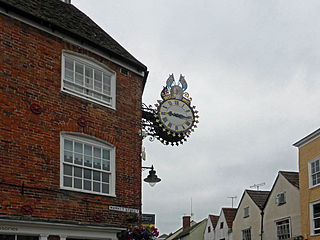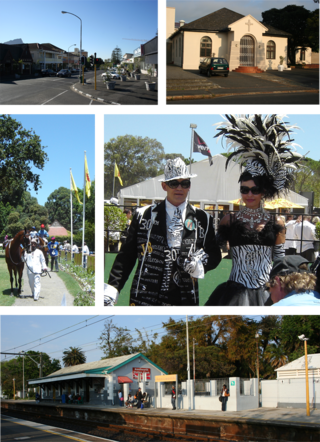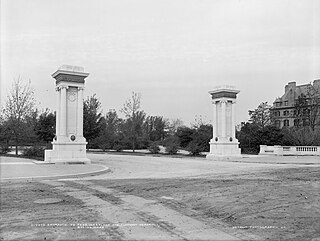
The Green Park, one of the Royal Parks of London, is in the City of Westminster, Central London. Green Park is to the north of the gardens and semi-circular forecourt of Buckingham Palace, across Constitution Hill road. The park is in the middle of a near-continuous chain of green spaces in Westminster that includes St James's Park, Hyde Park, and Kensington Gardens. To the northwest of Green Park is the district of St James's including, Lancaster House, Clarence House, and St James's Palace.

A street light, light pole, lamp pole, lamppost, street lamp, light standard, or lamp standard is a raised source of light on the edge of a road or path. Similar lights may be found on a railway platform. When urban electric power distribution became ubiquitous in developed countries in the 20th century, lights for urban streets followed, or sometimes led.
Eskom Hld SOC Ltd or Eskom (Afrikaans: Elektrisiteitsvoorsieningskommissie) is a South African electricity public utility. Eskom was established in 1923 as the Electricity Supply Commission (ESCOM). Eskom represents South Africa in the Southern African Power Pool. The utility is the largest producer of electricity in Africa, and was among the top utilities in the world in terms of generation capacity and sales. It is the largest of South Africa's state owned enterprises. Eskom operates a number of notable power stations, including Matimba Power Station and Medupi Power Station in Lephalale, Kusile Power Station in Witbank, Kendal Power Station, and Koeberg Nuclear Power Station in the Western Cape Province, the only nuclear power plant in Africa.

Rondebosch is one of the Southern Suburbs of Cape Town, South Africa. It is primarily a residential suburb, with shopping and business districts as well as the main campus of the University of Cape Town. The area is noted for its beautiful views of Table Mountain, its convent location to the rest of the city of Cape Town, and its proximity to the University of Cape Town.

A drinking fountain, also called a water fountain or water bubbler, is a fountain designed to provide drinking water. It consists of a basin with either continuously running water or a tap. The drinker bends down to the stream of water and swallows water directly from the stream. Modern indoor drinking fountains may incorporate filters to remove impurities from the water and chillers to lower its temperature. Drinking fountains are usually found in public places, like schools, rest areas, libraries, and grocery stores.

Sir Herbert Baker was an English architect remembered as the dominant force in South African architecture for two decades, and a major designer of some of New Delhi's most notable government structures. He was born and died at Owletts in Cobham, Kent.

Gqeberha, previously named Port Elizabeth, and colloquially referred to as P.E., is a major seaport and the most populous city in the Eastern Cape province of South Africa. It is the seat of the Nelson Mandela Bay Metropolitan Municipality, South Africa's second-smallest metropolitan municipality by area. It is the sixth-most populous city in South Africa and is the cultural, economic and financial hub of the Eastern Cape.

Possilpark, colloquially known as Possil, is a district in the Scottish city of Glasgow, situated north of the River Clyde and centred around Saracen Street. The area developed around Saracen Foundry of Walter MacFarlane & Co., which was the main employer. In the wake of the Saracen Foundry's closure in 1967, this part of Glasgow became one of the poorest in the United Kingdom, and decades later deprivation and crime rates remain high.

Wynberg is a southern suburb of the City of Cape Town in Western Cape, South Africa. It is situated between Plumstead and Kenilworth, and is a main transport hub for the Southern Suburbs of Cape Town.

Jubilee clock is a term used in reference to a number of clocks constructed and erected throughout the British Empire in commemoration of the Golden or Diamond Jubilee of various British monarchs, most commonly, Queen Victoria's.

Peel Park is a 22.6-hectare (56-acre) urban public park in the Bolton and Undercliffe area of Bradford, England, located about 0.75 miles (1.2 km) north-east of the city centre, and named after Sir Robert Peel (1788–1850). Peel Park was Bradford's first public park and is on the English Heritage and National Register of Historic Parks and Gardens online databases. The park is a Green Flag Award winner and has been for a number of years.

Kenilworth is a suburb in Cape Town, South Africa.

The Burnside Fountain is a non-functioning drinking fountain at the southeast corner of Worcester Common in Worcester, Massachusetts. It consists of two parts, a pink granite basin, and a bronze statue of a young boy riding a sea turtle. The basin was designed by architect Henry Bacon, who later designed the Lincoln Memorial in Washington, D.C., and the figure was created by sculptor Charles Y. Harvey. Harvey died by suicide before finishing the sculpture, and Sherry Fry completed the bronze. The Burnside Fountain was commissioned in 1905 by the city of Worcester after Harriet F. Burnside bequeathed US $5,000 to create a fountain to provide fresh water for people, horses and dogs, in the memory of her father, a prominent lawyer. The fountain was installed in 1912 in Central Square, then moved in 1969 to its current location on Worcester Common. In 1970 the statue was stolen, and was re-installed two years later. An attempted theft occurred in 2004.

The Saracen Foundry was the better-known name for the Possilpark, Glasgow-based foundry company W MacFarlane & Co. Ltd, founded and owned by Walter MacFarlane. MacFarlane's was the most important manufacturer of ornamental ironwork in Scotland.

Westland Gate is a pair of fountains that borders the Back Bay Fens at the end of Westland Avenue in Boston.

James Sellars was a Scottish architect who was heavily influenced by the work of Alexander Greek Thomson.

The Old Steine Gardens in Brighton, Brighton and Hove, East Sussex, England, adjacent to the Old Steine thoroughfare, are the site of several monuments of national historic significance.

The following outline is provided as an overview of and topical guide to Cape Town:

Overtoun Park is a public park in Rutherglen, South Lanarkshire, Scotland.




























